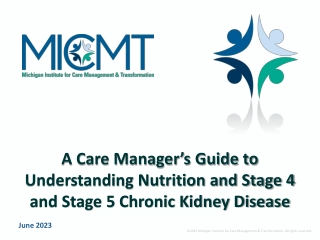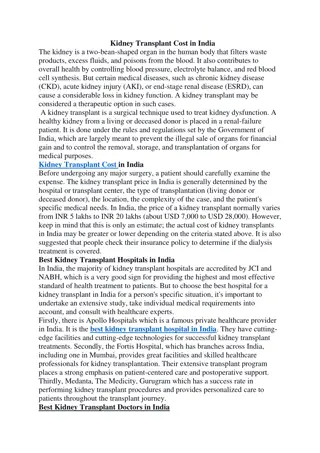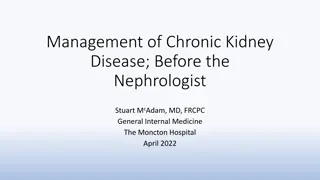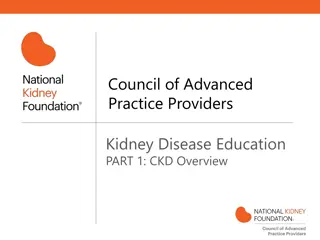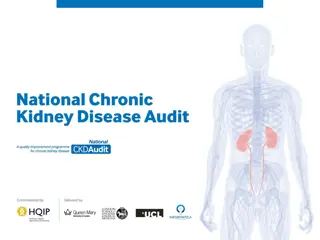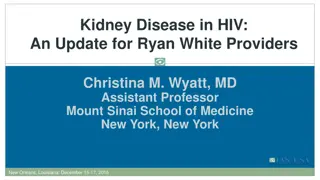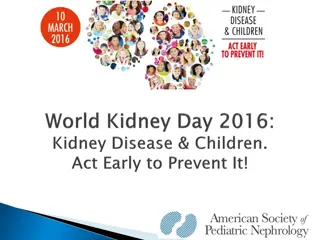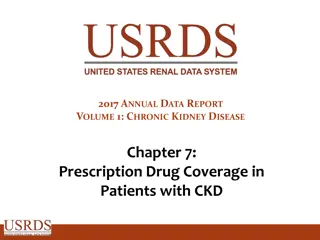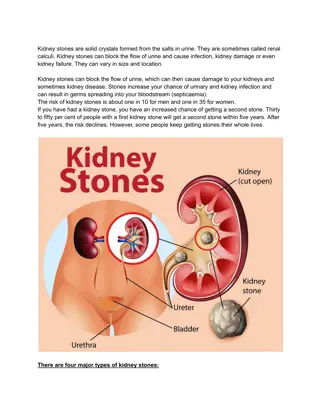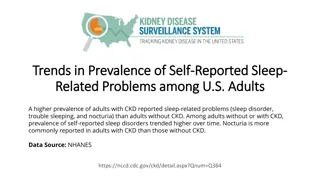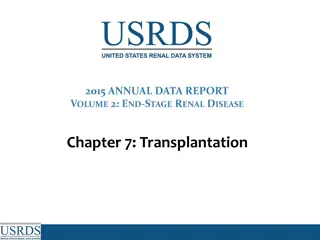Genetic Testing in Chronic Kidney Disease (CKD): Insights and Applications
Genetic testing plays a crucial role in identifying inherited kidney diseases, with around 15% of CKD cases having monogenic causes. Despite a high percentage of patients reporting a family history of CKD, Mendelian causes only account for about 10% of adult ESRD cases. Understanding the genetic basis of CKD is essential for early detection, personalized treatment, and improved management of the disease. Various methods, including identifying mutations and genomic structural changes, are used to uncover genetic defects contributing to CKD pathophysiology.
- Genetic testing
- Chronic Kidney Disease
- Monogenic kidney disease
- Inherited kidney disease
- Genetic defects
Download Presentation

Please find below an Image/Link to download the presentation.
The content on the website is provided AS IS for your information and personal use only. It may not be sold, licensed, or shared on other websites without obtaining consent from the author. Download presentation by click this link. If you encounter any issues during the download, it is possible that the publisher has removed the file from their server.
E N D
Presentation Transcript
Genetic testing in CKD when, how and why Kostas Stylianou Assistant Professor of Nephrology University of Crete Head of the Nephrology Department University Hospital of Heraklion
Kidney Genes The human genome contains 3.2 billion base pairs and the average genome differs from the reference genome at 4 million sites (variation 0.1%) There are 22000 known genes in the human genome, of which 4000 are known to cause disease, susceptibility to disease or benign changes in laboratory values Of these genes, 625 (15%) are known to cause monogenic kidney disease Susan Murray. Nephrol Dial Transplant (2020) 35: 1113 1132
Genetic or Familial CKD Around 25-37% of patients with CKD self-report a positive family history of CKD . Despite this high percentage, Mendelian causes are estimated to account for approximately 10% of cases of adult ESRD. This proportion is much higher in children (70%) Around 15% of all incident patients who reach ESRD lack a primary diagnosis (CKD or ESRD of unknown etiology). It is very likely that a significant proportion of them carry a genetic defect, responsible for the pathophysiology of their CKD.
Inherited kidney disease There are many kidney diseases that are inherited in a monogenic fashion due to a variant in a single gene, but there are equally as many kidney diseases that are influenced in a polygenic fashion (DM, HTN) Most Mendelian inherited kidney diseases are rare. However, as a group they represent a significant burden of disease. They are the main cause of CKD and ESRD in the pediatric population. doi:10.1038/nrneph.2017.167.
Mutations Single nucleotide variations Large structural variants (large DNA segments defects)
Types of Genomic Structural Changes Affecting Segments of DNA, Leading to Deletions, Duplications, Inversions, and CNV Changes (Biallelic, Multiallelic, and Complex)
Methods of genetic testing large DNA defects small DNA defects
Myriad methods have been employed to identify structural variants in the human genome. Estivill X, Armengol L (2007) Copy Number Variants and Common Disorders: Filling the Gaps and Exploring Complexity in Genome- Wide Association Studies. PLoS Genet 3(10): e190.
Genetic testing techniques We use Sanger analysis when the phenotype is highly specific for a particular genetic disease and to verify results from other tests Sanger sequencing is expensive and time consuming. Large genes (COL4A5, PKD1) Many Genes - Genetic heterogeneity (FSGS, nephrocalcinosis) In these instances massively parallel sequencing (MPS) is the preferred option: a) Targeted gene panels (NGS panel), b) whole exome sequencing (WES), and c) whole genome sequencing (WGS).
WHOLE & WHOLE GENOME SEQUENCING (WES, WGS) WES: Genomic technique for sequencing all protein-coding regions of genes (all exons = exome) constituting 1-2% of the genome. WES can detect 75% of the pathogenic mutations in the genome WGS analyzes whole genome (exons, introns, intergenic areas) and can detect the rest 25% of pathogenic mutations
WHOLE SEQUENCING (WES) The diagnostic yield of WES outperforms targeted gene panels in both adults and children WES allows for the discovery of new mutations, multiple mutations, incidental mutations in actionable genes, new phenotype-genotype correlations and for future re-analysis CNV detection is also possible but not always optimal. Difficult to analyze genes relevant to nephrology: a duplicated region of PKD1 and the tandem repeats of MUC1 (blind spots)
WHOLE GENOME SEQUENCING (WGS) WGS can characterize noncoding regions, enabling detection of splicing or regulatory variants. However, currently, there is limited benefit due to our incomplete understanding of the function of most of the noncoding regions It is more efficient than WES for rich GC content areas, and for CNV detection, (duplicated region of PKD1 or the MUC1 tandem repeats)
Genetic testing in Nephrology Diagnostic Yield Method Detects Example CMA (chromosomal micro arrays) CNVs & large DNA rearrangements (100kb) SNV, small Indels in selected genes (<250 bp) CAKUT 10-17% cJASN 2020 NGS PANELS FSGS, ALPORT, OXALURIA Up to 80% selected populations WES SNV Indels in coding DNA CKD unknown etiology NPHP-Ciliopathies (>90genes) Up to 70% PHP WGS SNV Indels in coding and non coding DNA CKD unknown etiology, aHUS (DGKE), Alport, Gitelman, PKD1 PKD1, GLA , HNF1b Detects 20-40% of mutations that are lost by CMA & WES MLPA (multiplex ligation dependent probe amplification) Long-range PCR large deletion-duplications (<50kb) GC-rich repeats ADTKD-MUC1 Groopman, Nat Rev Nephrol. 2018
Diagnostic yield from several cohorts tubulopathies cystic CKD SRNS CAKUT
The diagnostic yield depends on the presence of family history, age of presentation, and underlying pathology
Inverse correlation between frequency of a variant with the severity of phenotype (careful interpretation of the genetic results) UMOD The most rare variants: ADTKD The most common variant: CKD polygenic risk scores medullary cystic kidney disease-2 (MCKD2), autosomal dominant tubulointerstitial kidney disease (ADTKD) familial juvenile hyperuricemic nephropathy (FJHN)
Hereditary podocytopathies (first studied, early age) 80 genes so far
Schimke dysplasia WAGR Neil Patella
Identification of the cause of FSGS may have a significant impact on treatment. The majority of monogenic forms of FSGS do not respond to corticosteroids and have a very low risk of recurrence after transplantation. Identifying the underlying genetic cause may avoid unnecessary exposure to toxic steroid and other immunosuppressive regimens. Conversely, the absence of genetic mutations in structural components of the filtration barrier, would indicate an acquired, immunologic cause of the condition and would support the use of immunosuppression
Identification of the cause of FSGS may have a significant impact on treatment Genetic testing can identify cases that may respond to therapy with glucocorticoids (PLCE1) or cases that may benefit from other therapies: coenzyme Q10 supplementation when there is a coenzyme Q10 biosynthesis-associated mutations (ADCK4, COQ2, COQ6, PDSS2) vitamin B12 in the context of a cubilin mutation.
Figure 1 Kidney International 2023 DOI: (10.1016/j.kint.2023.04.022) Genetics, pave the way for the discovery of new treatments. Kidney disease associated APOL1 variants (G1 and G2) proteins form cation pores at the plasma membrane (PM) that transport Na+ and K+ down their concentration gradients across the PM, thereby causing podocyte injury. Inaxaplin specifically blocks the aberrant cation channel function of G1 and G2 and thereby prevents podocyte injury. Egbuna et al.8reported that Inaxaplin reduced proteinuria in APOL1-associated FSGS. Inhibition of APOL1 production either by blocking JAK-STAT signaling or by APOL1 antisense oligonucleotide is an alternative therapeutic strategy that is under investigation Kidney International 2023 104228-230DOI: (10.1016/j.kint.2023.04.022)
79 families with childhood-onset chronically increased echogenicity or 2 cysts on renal ultrasound.
Identifying the specific mutation can help determine the prognosis regarding age of onset, kidney prognosis and dysfunction of other organs
WES in 2 large cohorts combined: Assessment of Survival and Cardiovascular Events (AURORA), a clinical trial involving 2773 patients with ESRD who were 50-80 years of age. 280 medical centers, in 25 nations (Greece included) 2187 patients from the Columbia University Medical Center (CUMC) Genetic Studies CKD project, a genetic research and biobanking study recruiting patients who are seen by the CUMC Nephrology Division for the evaluation and management of nephropathy Emily E. Groopman. N Engl J Med 2019; 380:142-151DOI: 10.1056/NEJMoa1806891
Results 625 nephropathy-associated genes examined 59 genes are recommended by the ACMG for reporting as medically actionable diagnostic variants were detected in 307 of the 3315 patients (9.3%), encompassing 66 distinct monogenic disorders 206 (67%) had an autosomal dominant disease, 42 (14%) an autosomal recessive disease, and 54 (18%) an X-linked disease This yield is similar to that observed for cancer, for which genomic diagnostics are routinely used.
Results 202 variants (59%) had been previously reported as pathogenic 141 variants (41%) new. The majority of diagnostic variants (228 of 343 [66%]) were absent from population control databases (new or extremely rare?)
Results 652 renal genes, 39 diagnoses =6% have a clinical presence, 94% of known renal genes were not detected (extremely rare)
Variable clinical diagnostic spectrum before genetic testing
Results on Alport: in 62% we had no idea of the correct diagnosis Only 35 of the 91 patients (38%) with diagnostic variants in COL4A3, A4, A5 had a correct clinical diagnosis (Alport syndrome or BMD) The remaining 56 patients (62%) had other clinical diagnoses FSGS (16%), unspecified glomerulopathy (22%) congenital renal disease (4%), hypertensive nephropathy (3%), nephropathy of unknown origin (15%)
In the majority of these patients (89%), the genetic diagnosis gave a new clinical insight
Diagnostic implications For 88 of the 167 patients (53%), the genetic diagnosis could initiate referral and evaluation for previously unrecognized extrarenal features of the associated diseases, spanning 15 different medical specialties (ENT, eye, etc)
Diagnostic implications In a significant proportion of Pts (34%), the genetic findings reclassified their disease or provided a cause for undiagnosed nephropathy, emphasizing the usefulness of the agnostic approach of exome sequencing This approach assesses genes that otherwise may have gone unevaluated with the use of single-gene or phenotype-driven panel testing. Applying a phenotype-specific Gene panel in this study would have resolved, at most, 136 cases (44.3%) in the overall population.
Genetic diagnosis can help the physician to diagnose extrarenal pathologies
Therapeutic implications (CKD cohort) For 84 patients (50%), the genetic diagnosis could inform therapy: by disfavoring immunosuppression among patients who were found to have monogenic forms of FSGS, By initiating multidisciplinary care (e.g BRCA2), By leading to the initiation of tailored therapies (e.g Dent disease), By prompting referral to clinical trials that were targeted to the genetic disorder identified.
It always starts with a patient 63 yo Male in Hematology ward Low HDL, CKD4, Corneal opacities Familial LCAT deficiency Chronic anemia- unknown cause Splenomegaly Proteinuria- 40yo Anemia DMT2- 46yo Thrombocytopenia CKD3- 56yo
And then came a second one 43 yo Male Recurrent macroscopic hematuria after RTIs since childhood Proteinuria New onset DMT2 Corneal opacities Very low HDL eGFR 71ml/min/1,73m2
Our early experience with WES Renal diseases: 71% (10/14) diagnostic rate with WES Sex (M/F) Pt. Age (years) Phenotype Gene Disease Hematuria, proteinuria and hypertension 1 28 F COL4A5 Alport Syndrome Hypokalaemia, hypercalcaemia, and nephrocalcinosis 2 45 OCRL Dent disease 2 3 35 M Nephrotic syndrome, renal failure MAGI2 Nephrotic syndrome 15 4 40 F Hypokalemic alkalosis, hypocalciuria SLC12A3 Gitelman syndrome 5 22 F Focal segmental glomerulosclerosis PLCE1 Nephrotic syndrome 3 Cardiomyopathy, hyper- Keratosis palmoplantaris striata I Hypertrophic Cardiomyopathy & Keratosis palmoplantaris MYH7 DSG1 6 48 M retinitis pigmentosa proteinuria ADCK4 7 33 F Nephrotic syndrome 9 Cystic kidney disease, proteinuria ESRD 8 50 F COL4A5 Alport Syndrome 9 30 M C3GN CFH C3 glomerulopathy Cyclin M2 CNNM2 Renal Hypomagnesemia 6 10 32 F Severe Hypomagnesemia, Headaches
THE FIRST CASE DNAJB11 ASSOCIATED NEPHROPATHY IN GREECE (AUTOSOMAL DOMINANT POLYCYSTIC KIDNEY DISEASE-6/ ADPKD-6). WCN23-0585 K. Dermitzaki, I.Petrakis, E. Drosataki, M. Papapanagiotou, C. Pleros, D. Lygerou, I. Stavrakaki, M. Konidaki, M. Mitrakos, N. Papadakis, S. Maragou, A. Androvitsanea, N. Kroustalakis, K. Stylianou. Department of Nephrology, Heraklion University Hospital, Medical School, University of Crete, Greece Introduction: Many patients with a family history of chronic kidney disease (CKD) present multiple cystic kidney lesions without suffering from classical adult polycystic kidney disease (ADPKD). DNAJB11 associated nephropathy was first described in 2018 in 7 kindreds with monoallelic mutations in DNAJB11 gene (1). DNJAB11 shortage disrupts PKD1 maturation and transport in cellular membrane and causes an aberrant hold of uromodulin and MUC1 in the thick ascending limb of loop of Henle. These changes result in mixed polycystic and tubulointerstitial kidney disease phenotype with a late onset (60-90 years). DNAJB11 mutations are associated with the clinical phenotype in patients with ADPKD-6 (OMIM: 618061). The disease is transmitted with an autosomal dominant mode, renal cysts are usually small (0, 3-3 cm) and the kidneys are not enlarged. Some patients present with interstitial fibrosis and about half of them present liver cysts. Methods: Whole exome sequencing (WES) was performed within 3 generations of a kindred with microcystic kidney disease and CKD progression in advanced age (over 50 years). Bioinformatics analysis was performed with Ingenuity Clinical Insights software (Qiagen Inc.) utilizing Human Gene Mutation Database (HGMD). Conclusions: We are describing the first patient with ADPKD6 in Greece. The monoallelic mutation p.T178fd*10 in DNAJB11 causes polycystic kidney disease type 6 with late onset CKD and a full penetrance in each generation (2). Ongoing genetic analysis will show the exact prevalence in the island of Crete and will allow a better description of the clinical phenotype. Results: Index patient is a 59-year-old Caucasian female with CKD stage IIIa, bearing multiple cortical cysts in both kidneys (maximum diameter 2 cm), without kidney size enlargement and a positive family history for CKD: Her father and her grandfather developed CKD-III and IV respectively in advanced age. Clinically, the patient showed a large amount of angiokeratomas in her periumbilical region. Routine blood biochemistry other than renal function was normal. After obtaining informed consent we performed WES which showed a c.532delA (p.T178fs*10) in DNAJB11 gene (Figure 1). Fabry disease was excluded. Figure 1: Abundant renal cysts of variable dimensions within the renal parenchyma in our index patient (MRI) baring the mutation c.532delA (black box) resulting in an altered protein product (p.T178fs).
ADTKD Renal biopsy will not provide a precise diagnosis in ADTKD, Autosomal dominant pattern means that multiple family members may be affected, and the variable age of onset and bland radiological and urinary sediment findings mean it may be difficult to distinguish the affected from the unaffected through clinical screening alone. Thus, genetic testing is imperative. Urinary staining may become a useful non-invasive test for ADTKD-MUC1 (MUC1-fs). A small molecule P24 trafficking protein 9, has been shown to promote lysosomal degradation of the toxic MUC1-fs from cells and reverse proteinopathy. The same therapy may have potential treatment implications for ADTKD-UMOD and other proteinopathies.
ADTKD example. WES or MLPA ? Male 24 yo, progressive decline of eGFR Left kidney agenesis, pancreatic body and tail agenesis NID-DM since age 22, currently on GLP1 agonist Normal liver function, Magnesiuria, Hypomagnesemia, Hyperparathyroidism Hypospadias repair surgery some years ago. Brother with similar phenotype plus liver dysfunction Grandmother and mother with DM
WES or MLPA ? WES SLC12A3 c.791C>G HOMO, common variant COL4A3 C1721C>T (p.Pro574Leu) HOMO, benign HNF1A c.1460 G>A ,HOMO, DOM, CADD 18, benign HNF1A c.79A>C, HOMO DOM, CADD=22, benign PKD2 c.-82 G>C, benign PHEX c1482+31_1482+32delTT GnomAD=0%, VUS MLPA: HETEROZYGOUS, DELETION of HNF1B gene, AUTOSOMAL DOMINANT DISEASE (MODY5)
Study of complement proteins in aHUS & C3G (KDIGO) Goodship: aHUS and C3 glomerulopathy: a KDIGO conference report Kidney International (2017) 91, 539 551
Diagnostic yield of genetic testing in aHUS https://doi.org/10.1038/s41581-021-00424-4
Complement genetics in aHUS is a valuable tool To provide proof of a link between complement dysregulation and the disease, to assess disease severity to predict the risk of recurrence after kidney transplantation and enable prophylactic complement blockade To predict the risk of disease relapse after discontinuation of eculizumab treatment (60% vs 5%).


